
The Bottom Line
Introduction, Quick Specs and Availability & Price
This is the video card you've been waiting for: the NVIDIA GeForce GTX 980 Ti. I have a few friends who have been waiting to upgrade their GeForce GTX 780 Ti video cards, who skipped the GTX 980 when it came out, salivated over the Titan X when it was released, but ultimately waited for the GTX 980 Ti.
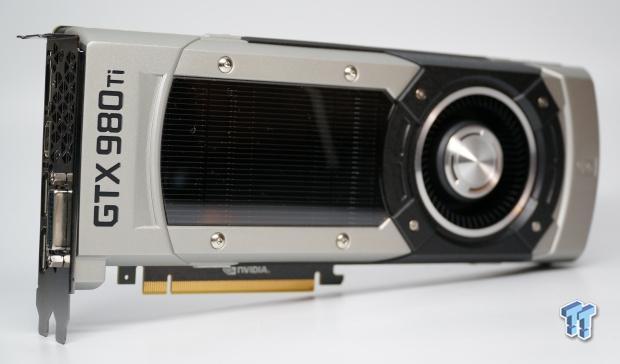
We are weeks away from being introduced to AMD's next-gen Radeon R9 390X, the world's first video card to use the truly next-gen High Bandwidth Memory, or HBM. The Fiji XT-based card is sure to heat things up for the video card market, but is the GeForce GTX 980 Ti NVIDIA's answer to the R9 390X? Only time will tell.
At the time of the review, I have 72 hours before I get on a plane for Taipei for Computex, where all rumors have pointed to AMD teasing its Radeon R9 390X. Other rumors have AMD pegged for E3 2015 which is the week after, but NVIDIA is pulling the trigger on the GM200-powered GTX 980 Ti now, and for good reason: it kicks ass, big time.
I think one of the biggest things that the GTX 980 Ti has for it, outside of its performance, is that NVIDIA is allowing add-in board partners to use aftermarket coolers. The Titan X only arrived in the reference cooler with a handful of waterblocks made for it by various companies.
Everything changes with the GTX 980 Ti, as NVIDIA is allowing for aftermarket coolers which is going to really change things when it comes to offering consumers a bevy of options with the GM200-powered GTX 980 Ti. I'm positively buzzed with excitement to see what the likes of ASUS, MSI, EVGA, ZOTAC and all of the other AIBs can offer.
Quick Specs
One of the key differences between the GeForce GTX 980 and GeForce GTX 980 Ti is that the GTX 980 Ti is based off the GM200 core, the same GPU that powers the Titan X. The GTX 980 on the other hand is powered by the GM204, which is a cut down version of the GM200 core.
Thanks to NVIDIA using the GM200 core, we're effectively receiving a cut down Titan X with half of the framebuffer, with 6GB of GDDR5 instead of the 12GB of GDDR5 found on the Titan X. 12GB of VRAM is completely overkill for 99.9% of gamers at this point in time, which is where the GTX 980 Ti steps in.
Availability & Price
NVIDIA is pricing the GeForce GTX 980 Ti at $649, which is quite competitive as there's no real competition from AMD just yet. The nearly two-year-old Radeon R9 290X is expected to be replaced by the Radeon R9 390X, but with rumors of an MSRP of $849, NVIDIA could have a real star on its hands.
The company has pushed down the price of its GTX 980, too, down to $499. This means you're paying a $150 premium for the 980 Ti, but with the Titan X still at $999 - you're going to want to read on to find out why you will be so tempted to grab the GTX 980 Ti.
Packaging & Detailed Look
The Packaging
NVIDIA's reference cards always arrive in sexy as hell packaging, with the GeForce GTX 980 Ti being no exception. The chipmaker has modified the box slightly from the Titan X, as you can see in the images below.
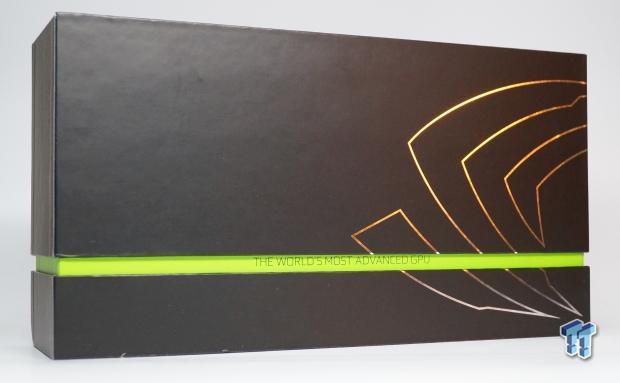
The outside of the box, in all its glory.
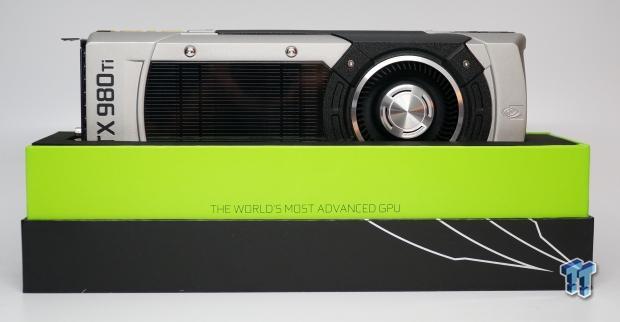
The money shot: the GeForce GTX 980 Ti inside of NVIDIA's incredibly beautiful packaging.
Detailed Look
I'm still such a big fan of the reference cooler that NVIDIA has used on the GTX 980 Ti, which is the same used on the previous two Maxwell cards in the GTX 980 and Titan X. If the 'Ti' wasn't there, you wouldn't be able to tell the difference between the GTX 980 and GTX 980 Ti easily.
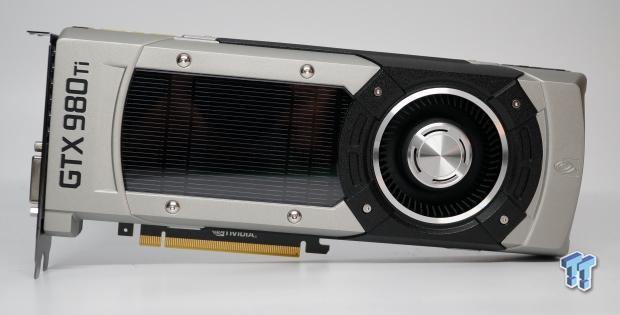
The front of the card, where to the left of the picture we can see this is a "GTX 980 Ti".
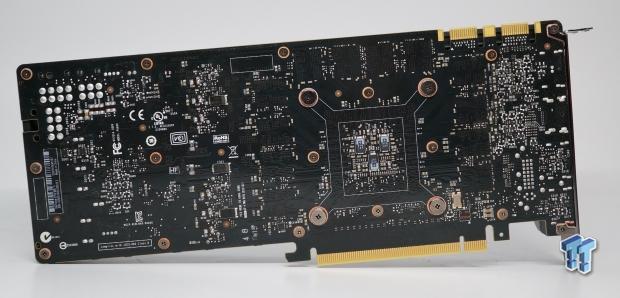
The rear of the reference GeForce GTX 980 Ti.

We have the same GeForce GTX branding on the GTX 980 Ti, something that you can control the LEDs through using NVIDIA's GeForce Experience software.

The usual display output configuration: three DisplayPort 1.2 ports, one HDMI 2.0 and a DVI output.
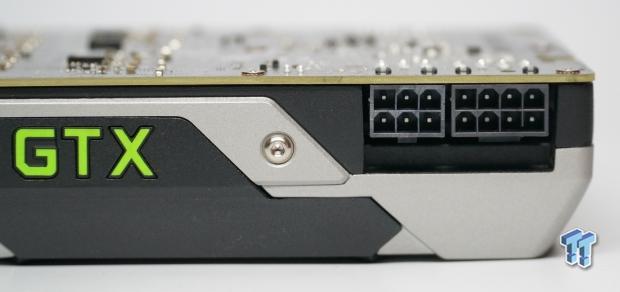
The GTX 980 Ti has a 250W TDP, which is why NVIDIA has opted for a 6-pin + 8-pin PCIe power requirement.
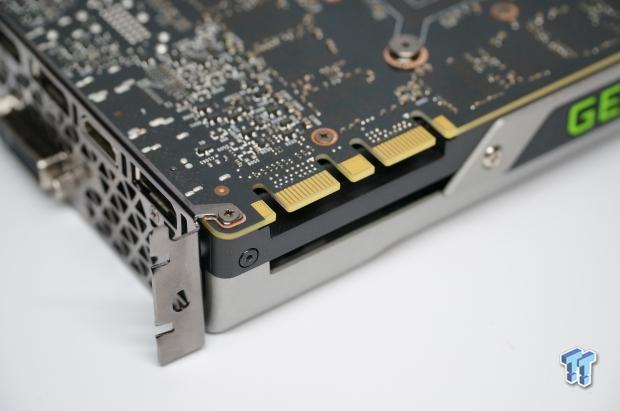
NVIDIA is allowing four of the GeForce GTX 980 Ti cards to be used in SLI for some serious performance.
Card Specifications & Cooling Setup
Card Specifications
NVIDIA has used the same GM200 core that powered the Titan X, but reduced the CUDA core count to 2816. The VRAM has been reduced too, down from 12GB found on the Titan X, to 6GB on the 980 Ti. We have eight billion transistors inside of the GTX 980 Ti, with 22 SM units, 176 texture units, representing a 38% increase over the GTX 980.
One of the bigger improvements over the GTX 980 is that the GTX 980 Ti features a 384-bit memory bus, up from the 256-bit memory bus on the GTX 980. This gives the GTX 980 Ti memory bandwidth of 336.5GB/sec, an increase of 50% over the GTX 980.
Cooling Setup
As we said before, NVIDIA has used the blower cooler design that the company has used for quite some time now. The GeForce GTX 780, GTX 780 Ti, GTX 970, GTX 980, Titan X and now the GTX 980 Ti all use the same reference cooler design. It does the job, but I'm very much looking forward to seeing what ZOTAC, ASUS, MSI and the rest of the AIB partners can do with aftermarket coolers.
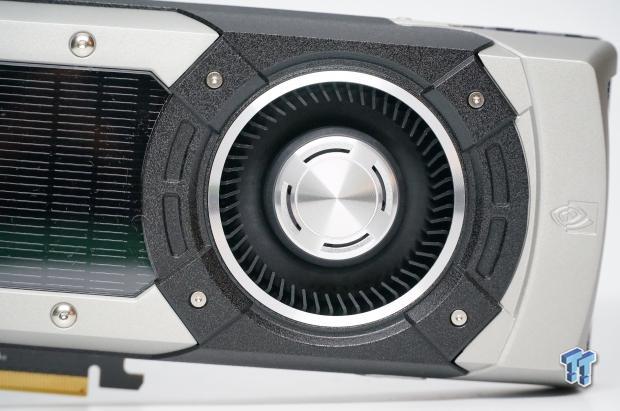
Here's an up close shot of the blower fan itself, which is surprisingly quiet for how chunky it is, even under extreme load (like 4K Surround).
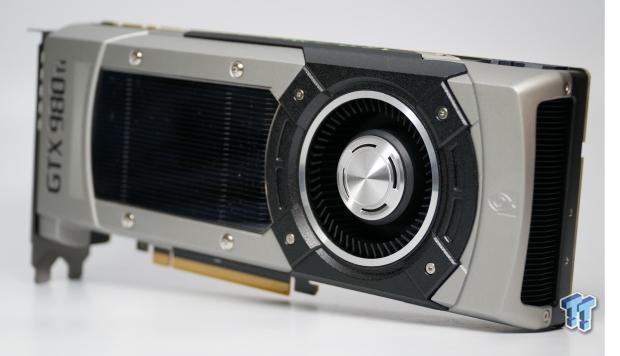
And again from a different angle.
Testing Method & Test System Configuration
Testing Method
Because I'm just starting out reviewing GPUs, we're going to slowly evolve our benchmarking setup. I'm not going to dive into the deep end and start testing out real-time FPS, as this will hurt the quality of the reviews. Instead, I'd like to nail these initial reviews and then we can start doing real-time numbers of games like Far Cry 4, and Star Citizen. For now, I've played Battlefield 4 on a 64-player server to provide some real-world performance numbers.
For now, I'm going to be using the same suite of benchmarks I've been using on my Tweakipedia articles, which uses a mix of synthetic benchmarks with Futuremark's 3DMark and Unigine Heaven. After that, we have a bunch of titles with built-in benchmarks (which does not represent actual in-game performance) but they are repeatable for you at home to gauge the performance of your PC or GPU.
Over time, I will be adding in new benchmarks and a new section that will concentrate solely on real-time gaming benchmarks. This will take more time per review, as I'll have to invest time into actually physically playing the games, but it'll be worth it in the long run. For now, let's get right into the synthetic benchmarks and see how this ASUS GeForce GTX 980 Matrix Platinum performs.
Test System Configuration
We only recently built our new X99-powered system, something you can read about here. As for the detailed specifications, this is what we're running:
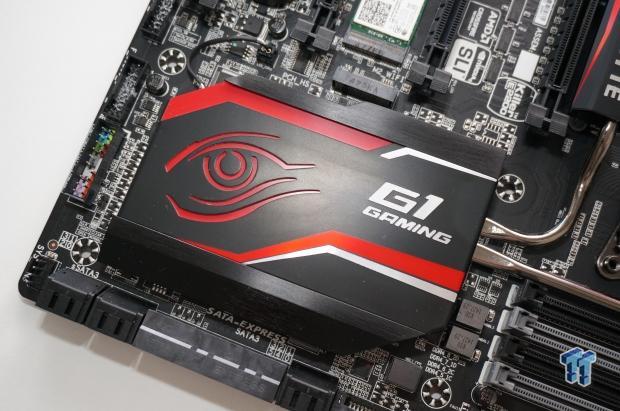
- CPU: Intel Core i7 5820K processor w/Corsair H110 cooler
- Motherboard: GIGABYTE X99 Gaming G1 Wi-Fi
- RAM: 16GB Corsair Vengeance 2666MHz DDR4
- Storage: 240GB SanDisk Extreme II and 480GB SanDisk Extreme II
- Chassis: Lian Li T60 Pit Stop
- PSU: Corsair AX1200i digital PSU
- Software: Windows 7 Ultimate x64
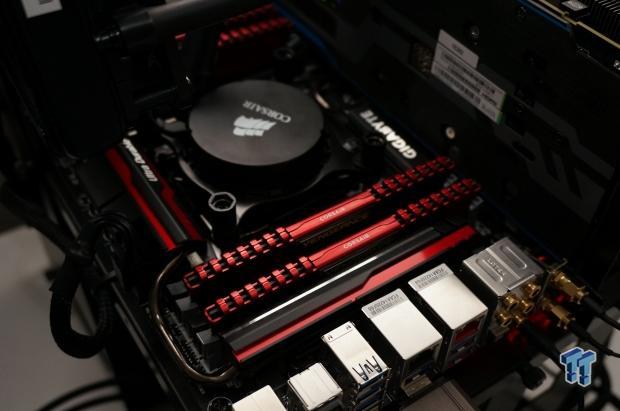
We're running the system at stock CPU speeds, which will provide more of a 'real-world' feel to our benchmarks. Sure, this isn't an i7-5960X at 5GHz, but what person is going to team up an incredibly expensive CPU with a mid-range GPU? Not many.
Our GPU tests are changing, shifting toward more of a real-world feel. But don't worry, we will be doing some crazy balls-to-the-wall tests that will see serious overclocks, Extreme Edition processors, and much more in the coming months. For the most part, we will be doing more real-world testing by teaming up the right processor with the right GPU in its price category.
Benchmarks - Synthetic (3DMark and Heaven)
3DMark Fire Strike - 1080p
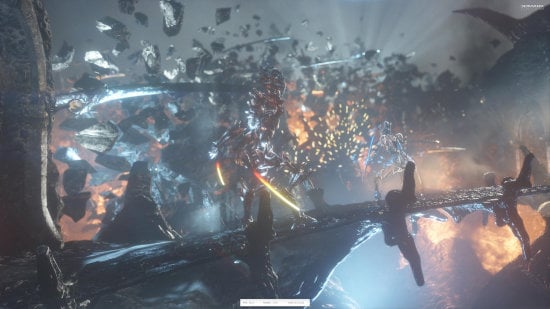
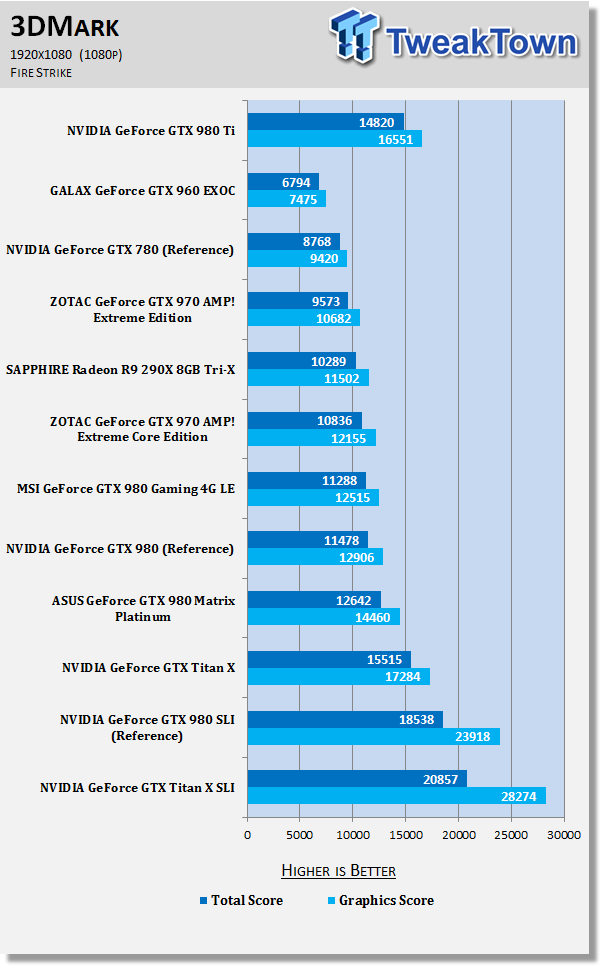
3DMark Fire Strike Extreme - 1440p
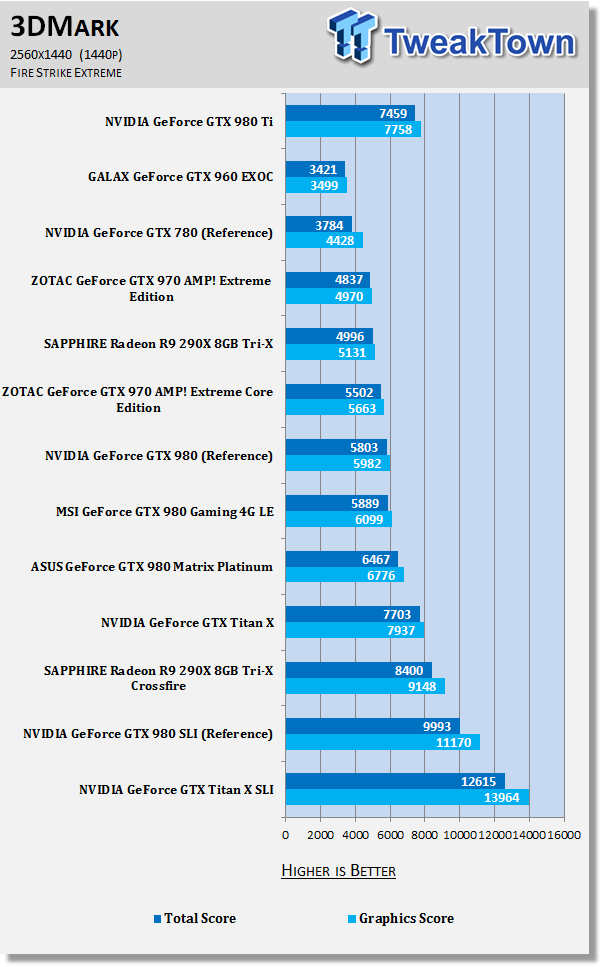
3DMark Fire Strike Ultra - 4K
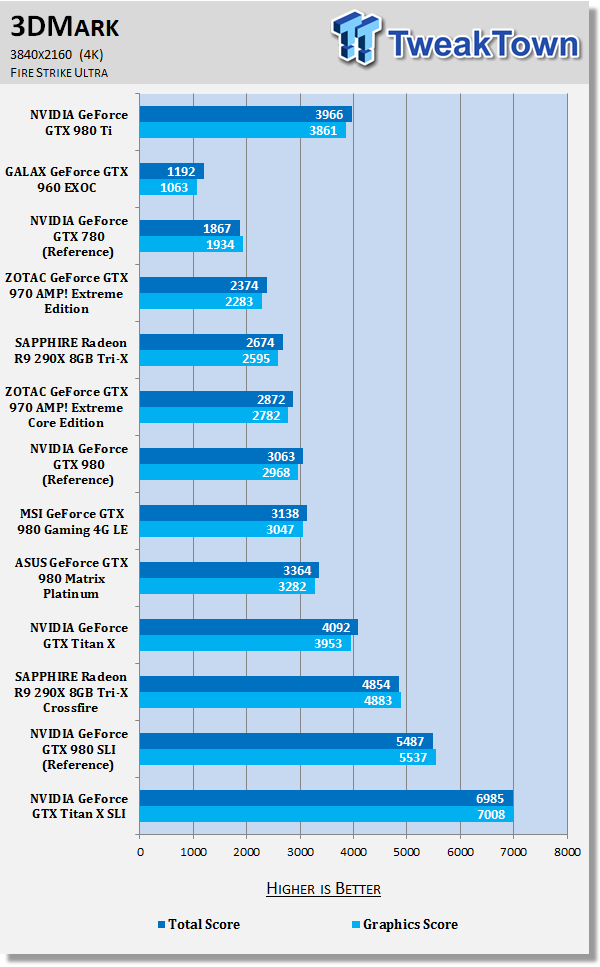
Heaven - 1080p
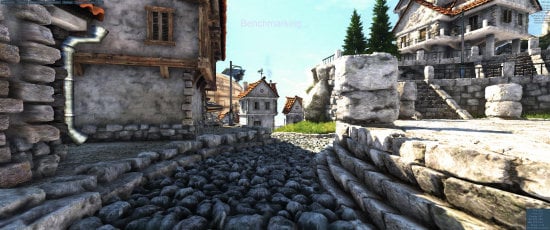
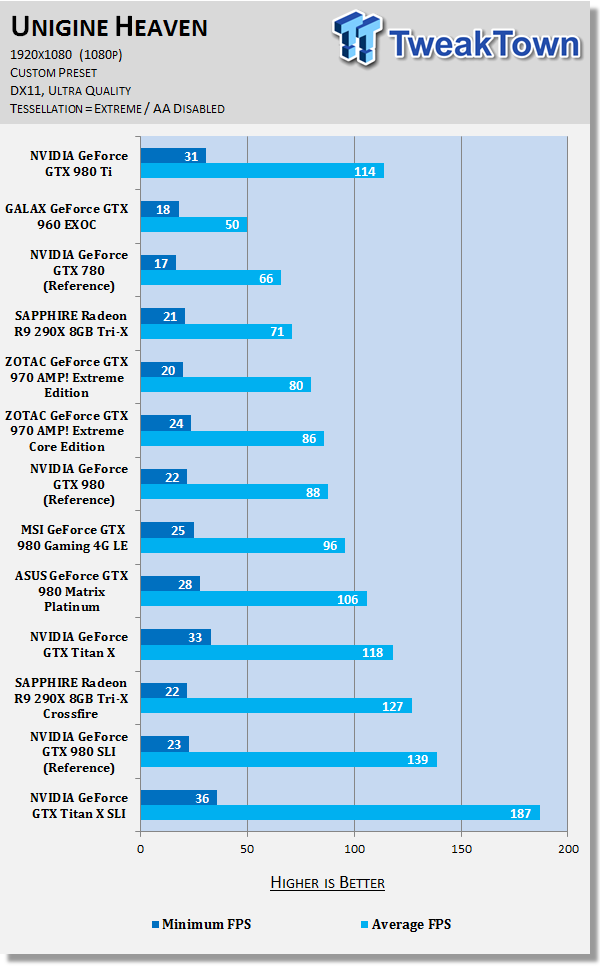
Heaven - 1440p
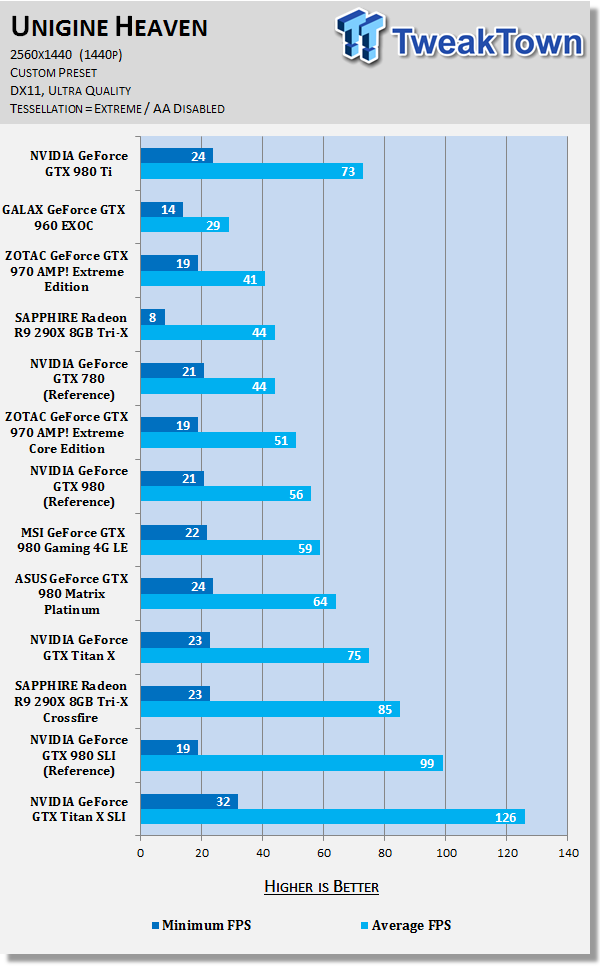
Heaven - 4K
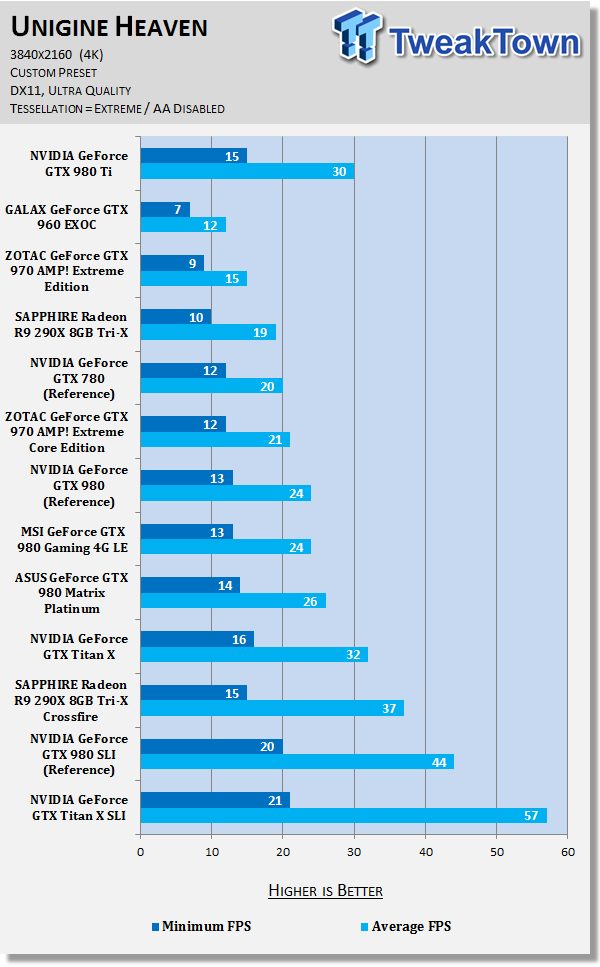
Starting with 3DMark at 1080p, the GTX 980 Ti destroys the GTX 780 with close to 100% more performance. Even up against the GTX 980, the GTX 980 Ti is a chunk faster. Moving up to 1440p and 4K we see the same dominance thanks to that GM200 core and its wider 384-bit memory bus.
The performance improvements continue with Heaven, where the GeForce GTX 980 Ti destroys the GTX 780, and enjoys bashing on the GTX 980. The GTX 980 Ti also gets awfully close to the Titan X where it is just a few percentage points away from the Titan X's performance.
Game Benchmarks (1080p)
Battlefield 4
This is one game that we did differently, as it does not feature a built-in benchmarking feature. When it comes to Battlefield 4, there are countless ways you can benchmark it. Some find a spot in the single player campaign which is easily repeatable, and use that. For our testing, we've chosen to use a 64-player online multiplayer server for real-time performance statistics.
We joined a 64-player map and played for five minutes using FRAPS, pulling our minimum/average and maximum FPS. We did this for each test, we run the game for 5 minutes at 1080p/1440p and 4K two times each. One time with Medium settings, and another with a custom Ultra preset (disabling AA). It's time consuming, but it gives us a perfect look into true real-world performance.

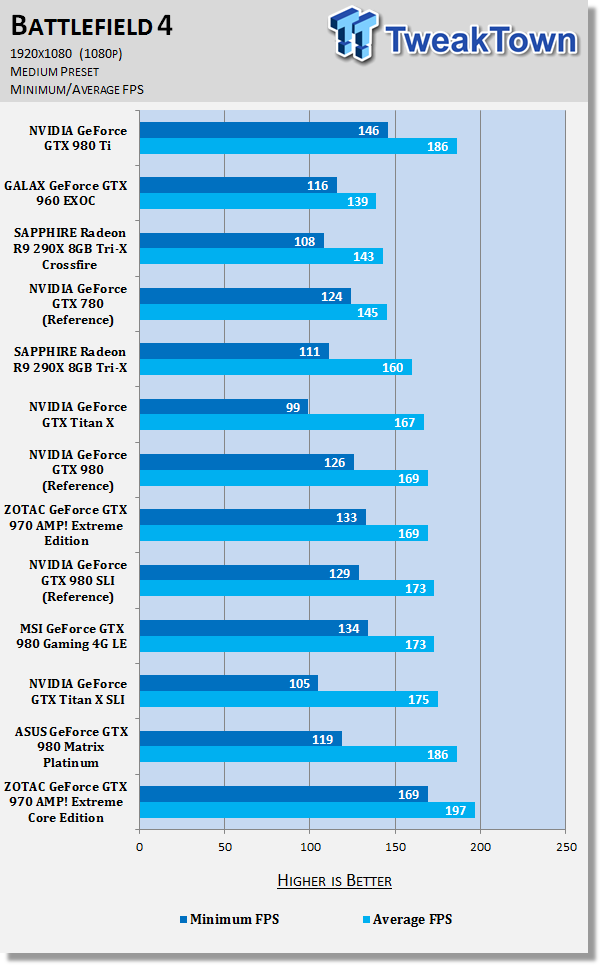
And again, this time with the Ultra preset.
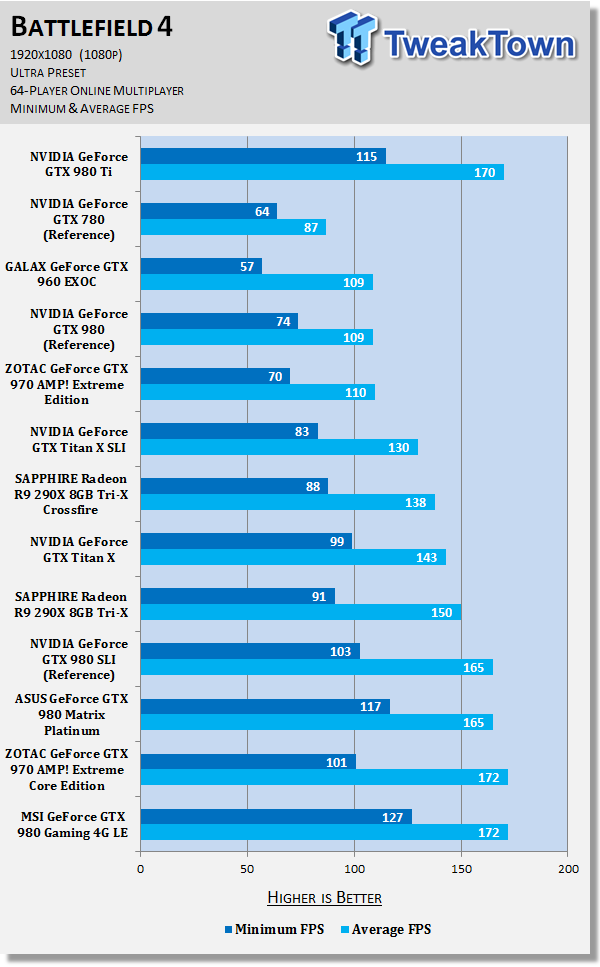
Grand Theft Auto V

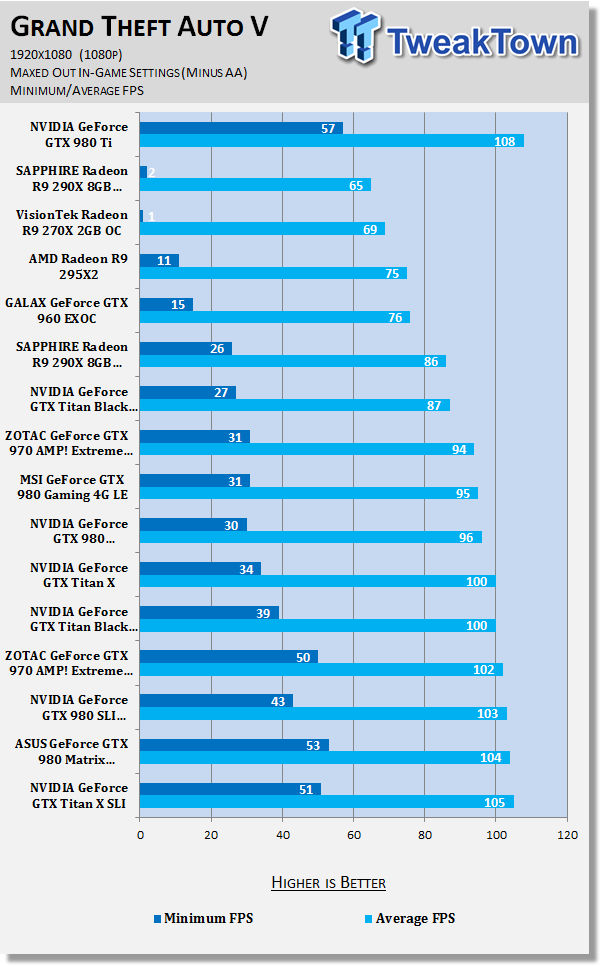
GRID Autosport

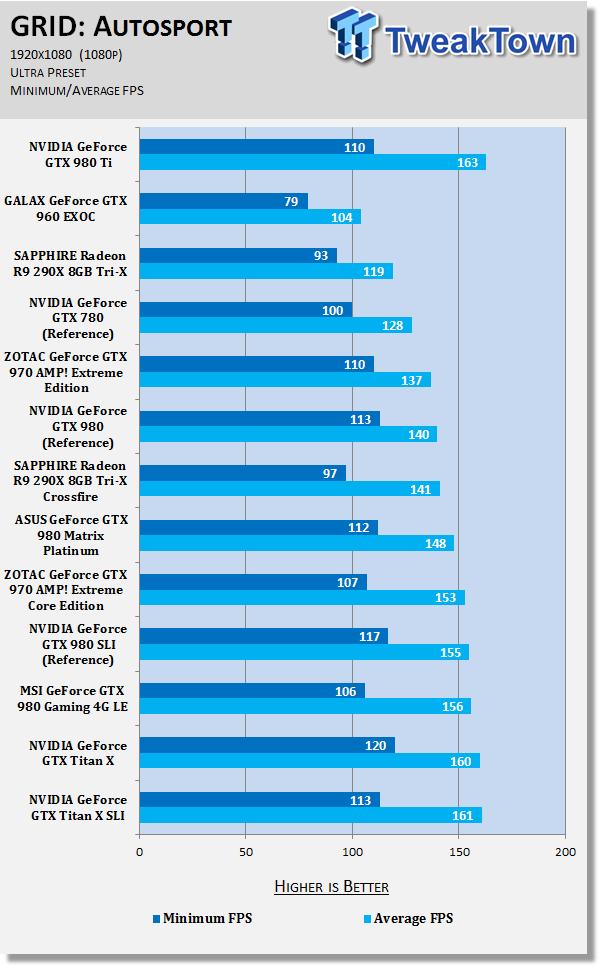
Metro: Last Light

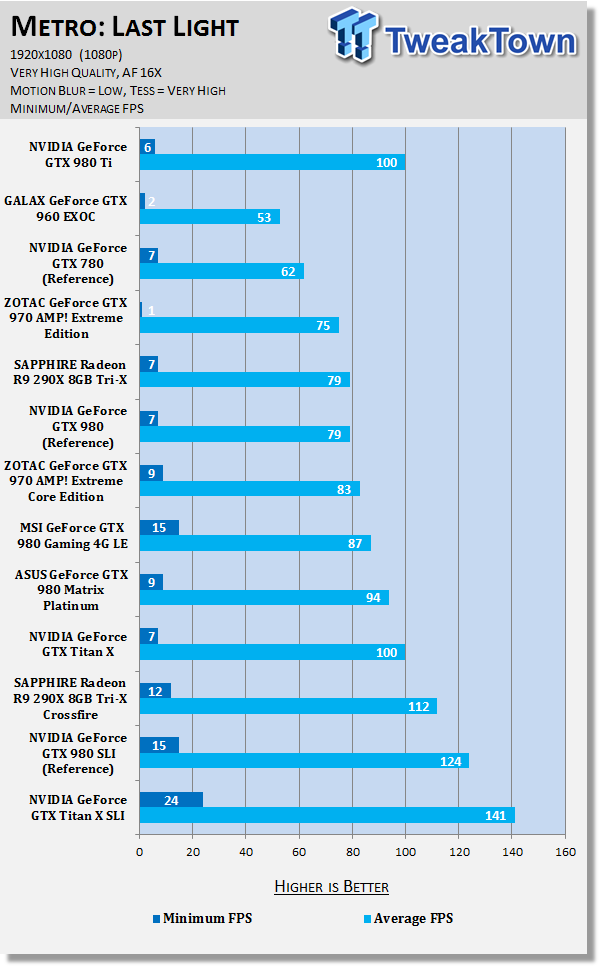
Middle-earth: Shadow of Mordor

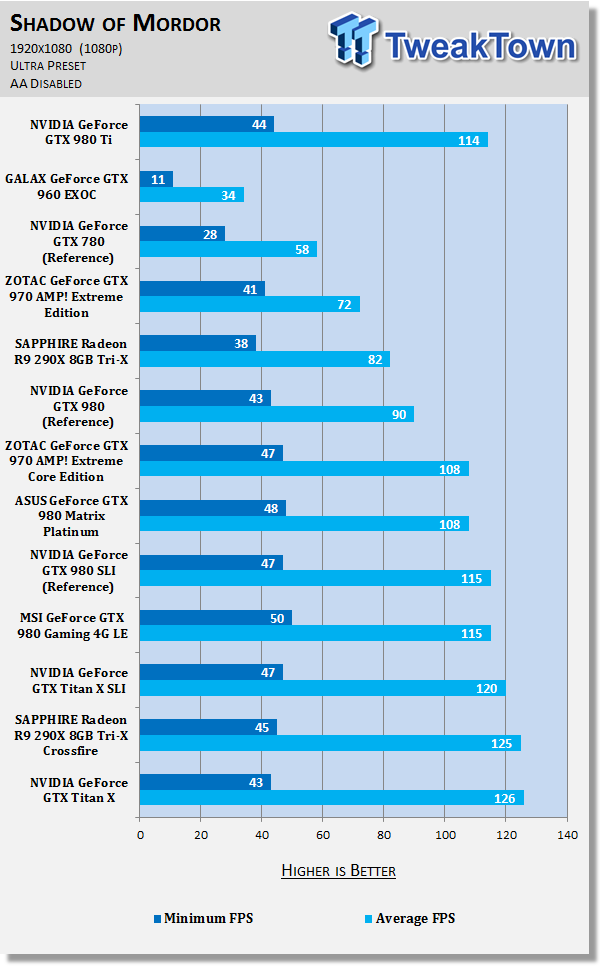
Thief

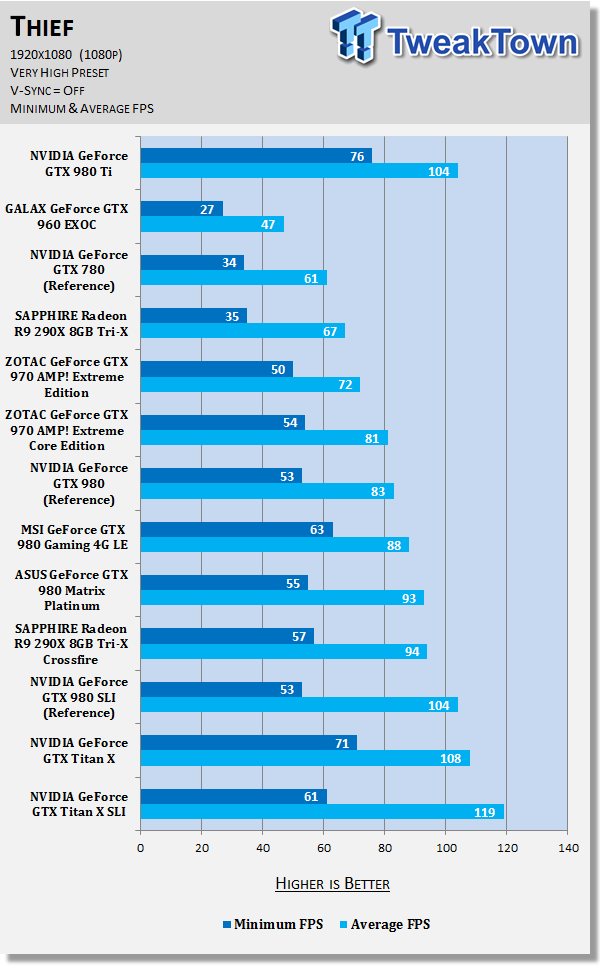
Tomb Raider

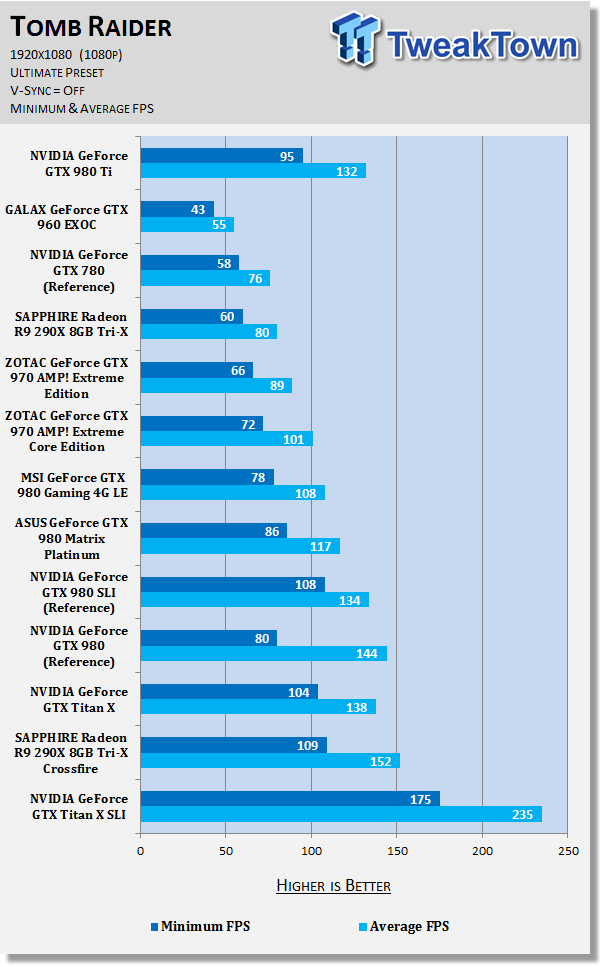
BioShock Infinite

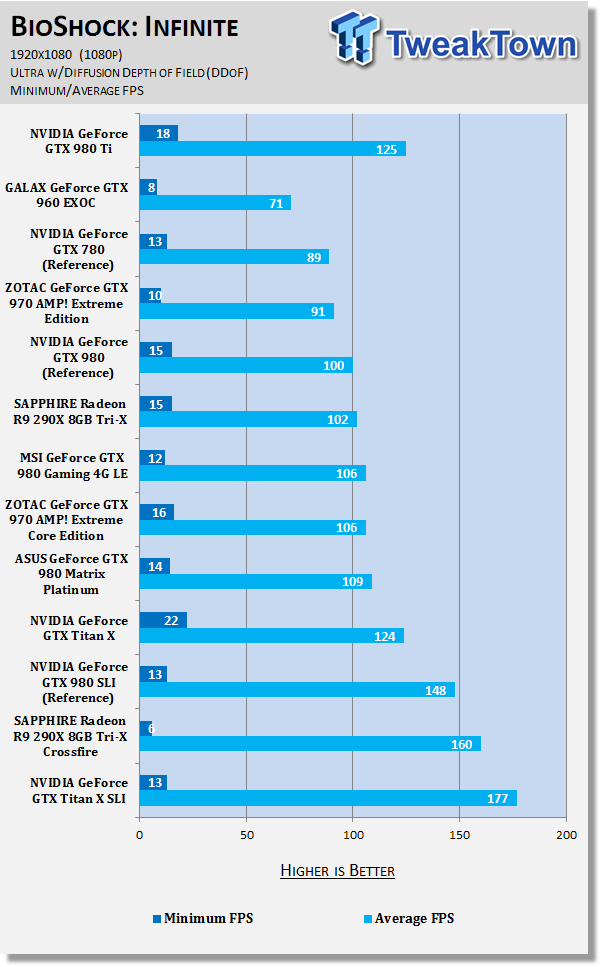
DiRT Showdown
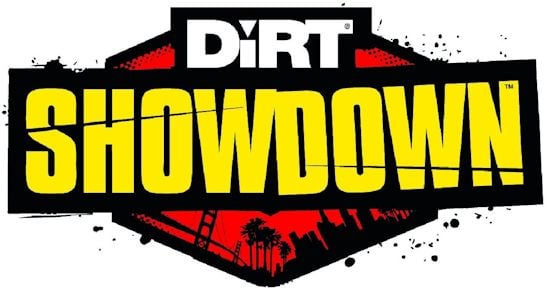

You can find our performance summary of all of our gaming tests later in the review.
Game Benchmarks (1440p)
Battlefield 4

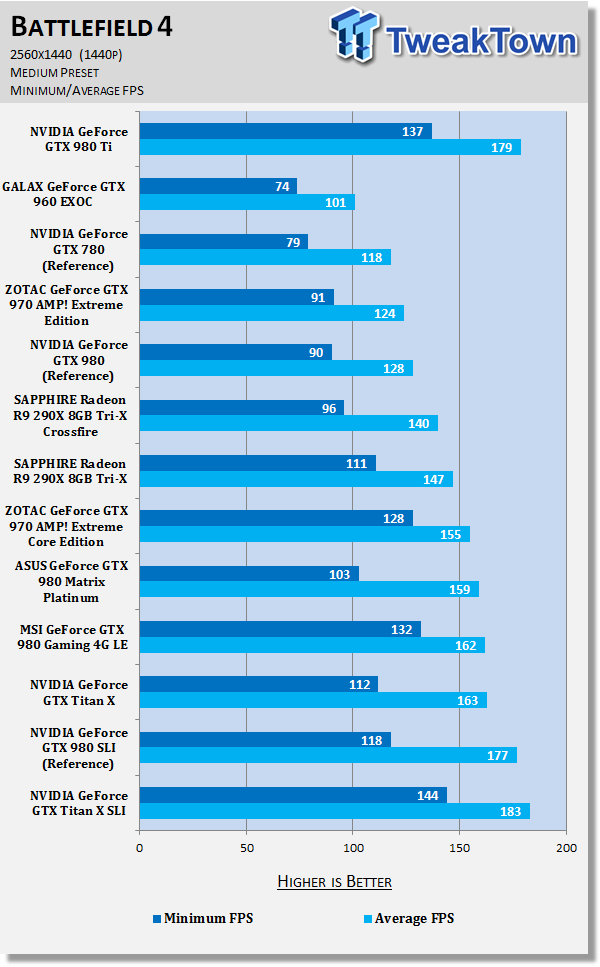
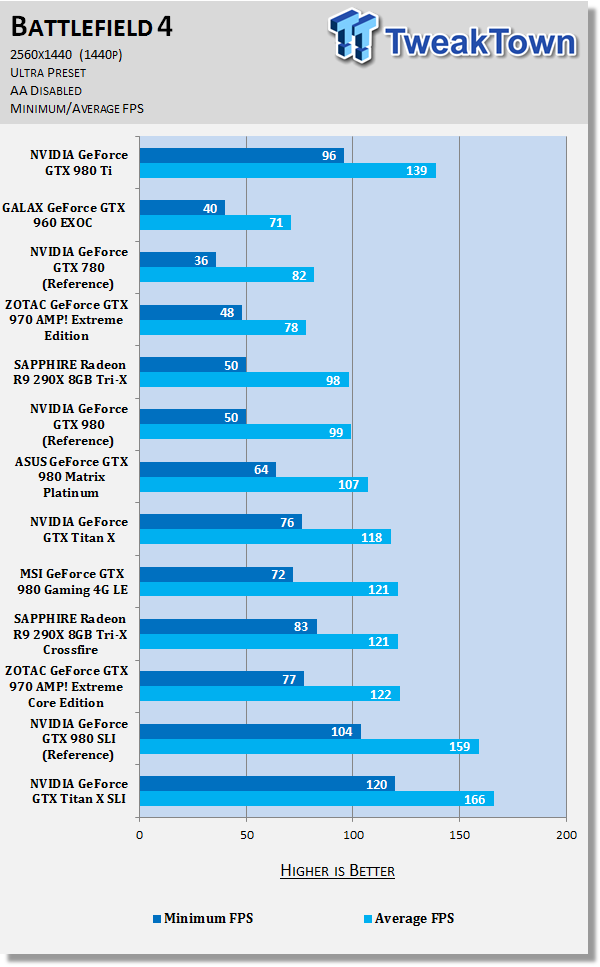
Grand Theft Auto V


GRID Autosport

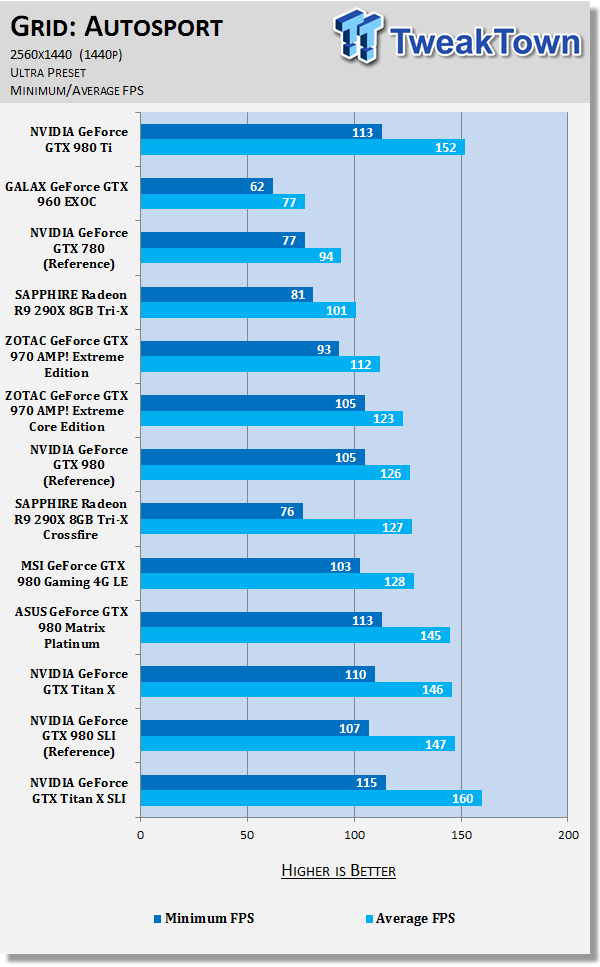
Metro: Last Light

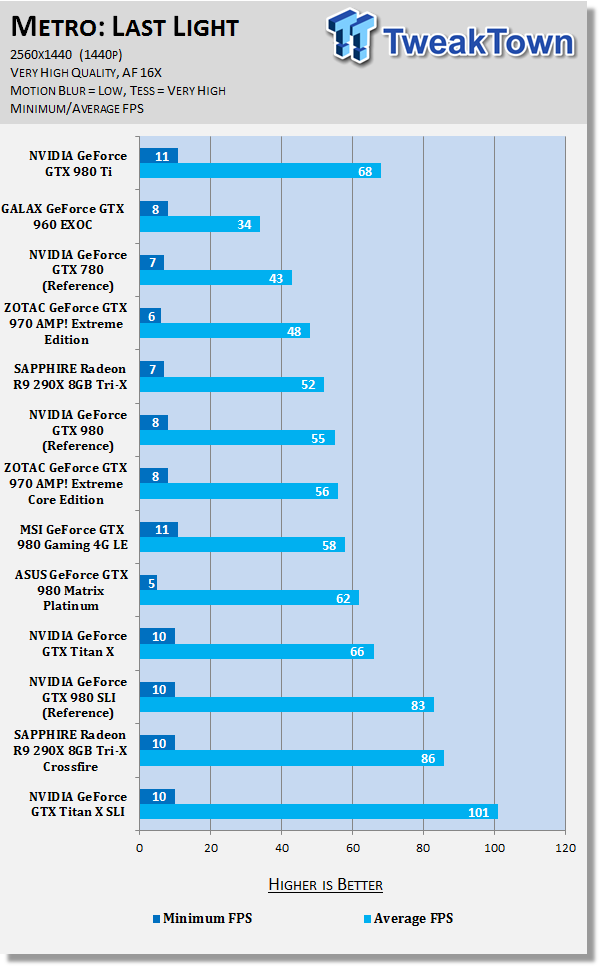
Middle-earth: Shadow of Mordor

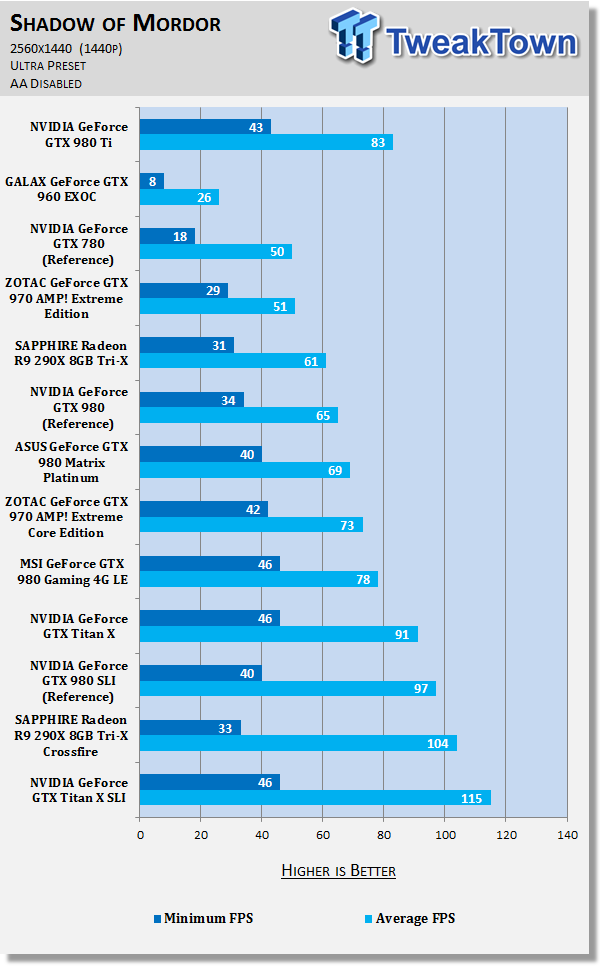
Thief

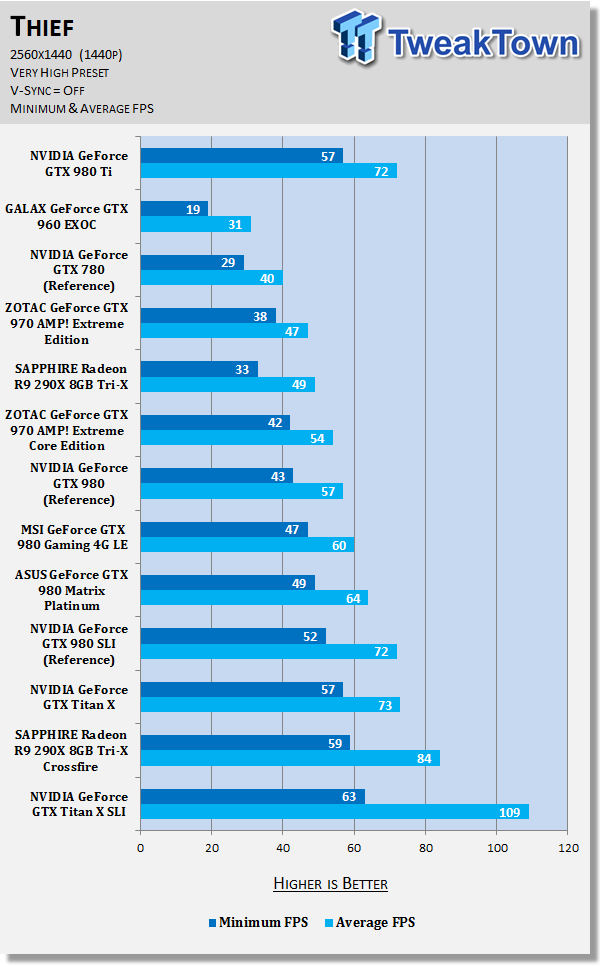
Tomb Raider

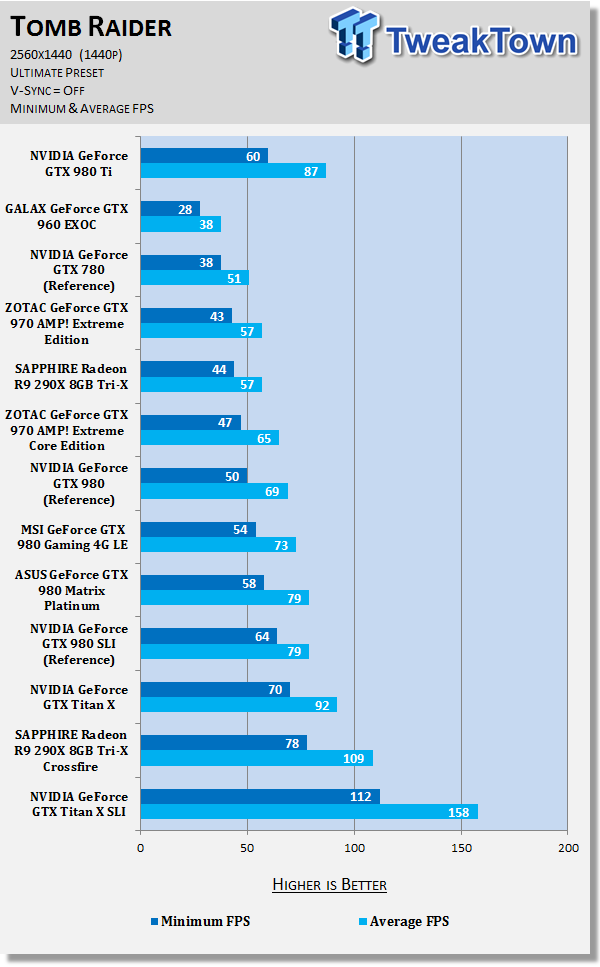
BioShock Infinite

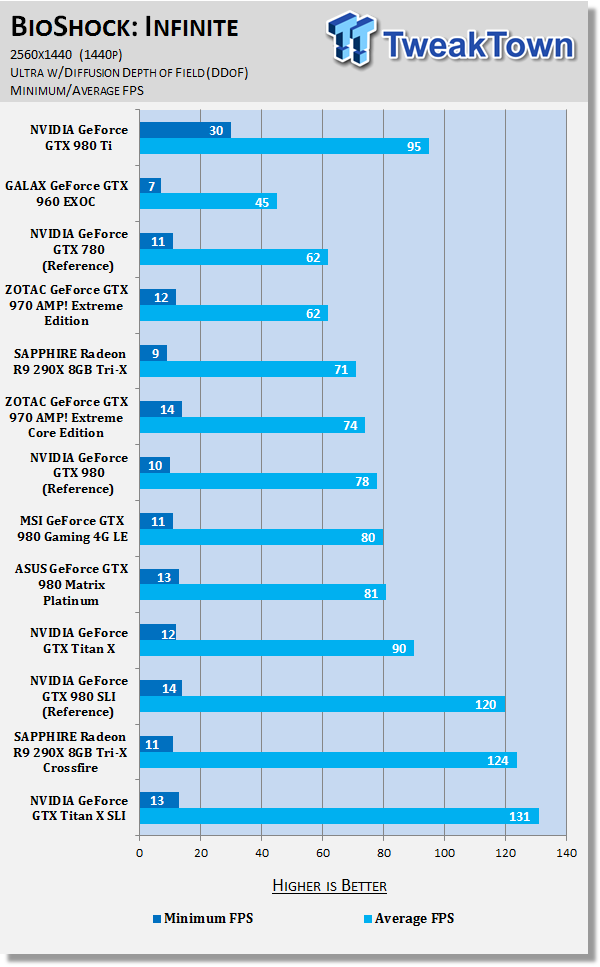
DiRT Showdown


You can find our performance summary of all of our gaming tests later in the review.
Game Benchmarks (4K)
Battlefield 4

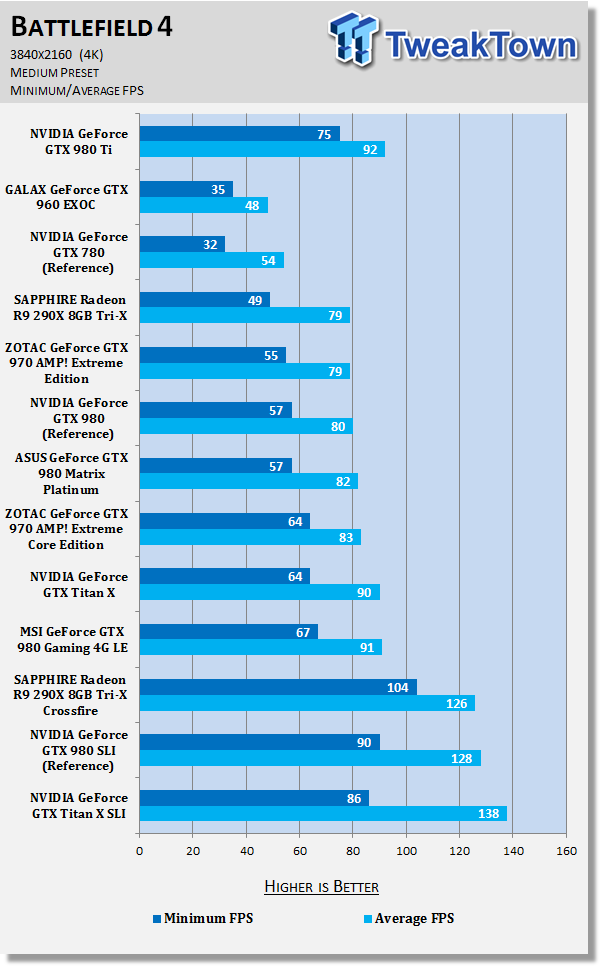
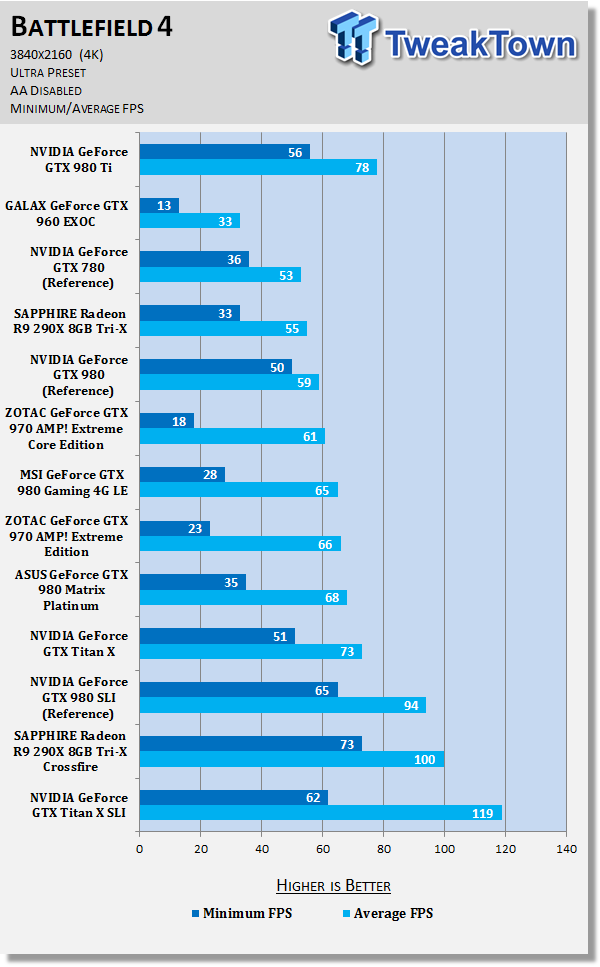
Grand Theft Auto V

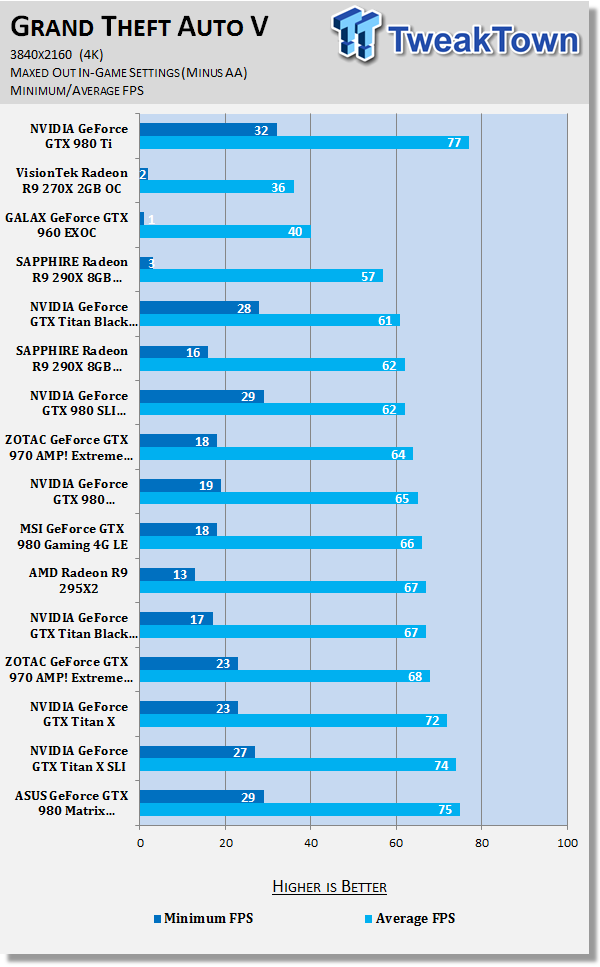
GRID Autosport

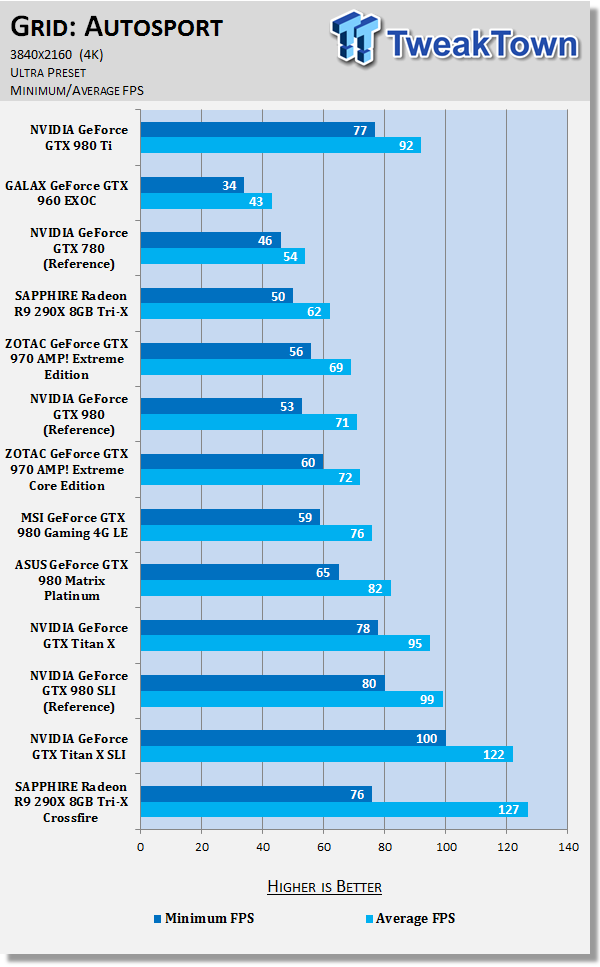
Metro: Last Light


Middle-earth: Shadow of Mordor

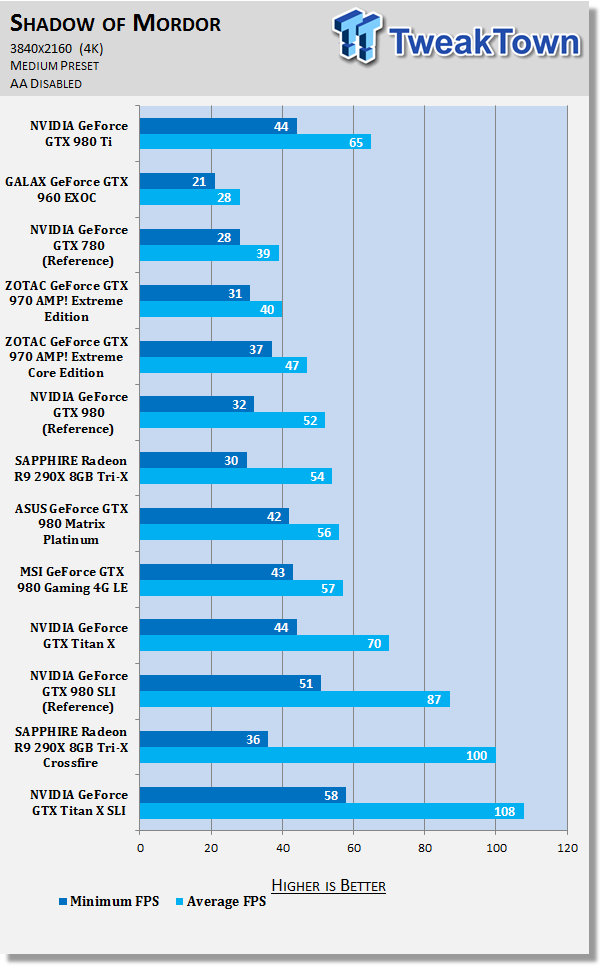
Thief

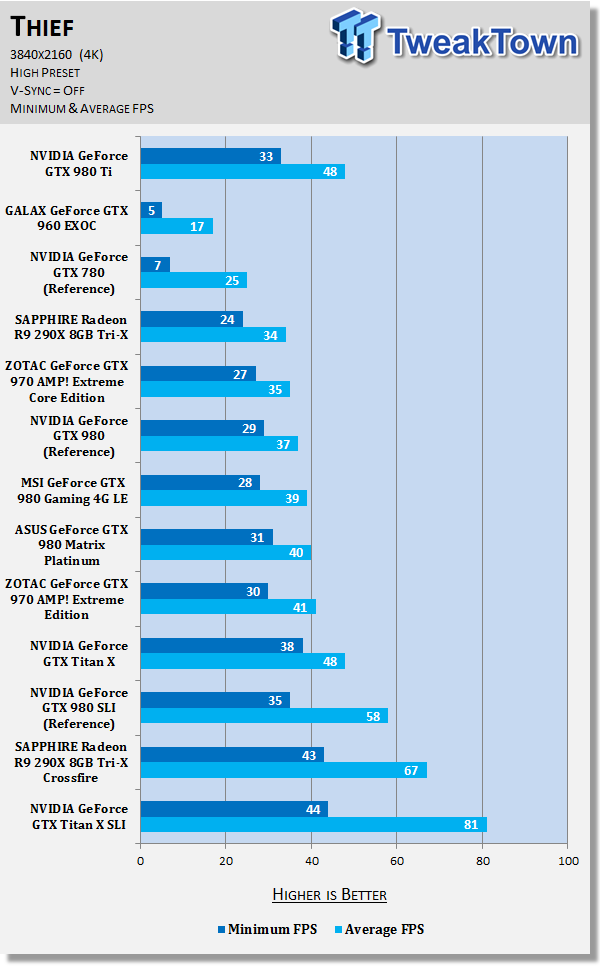
Tomb Raider

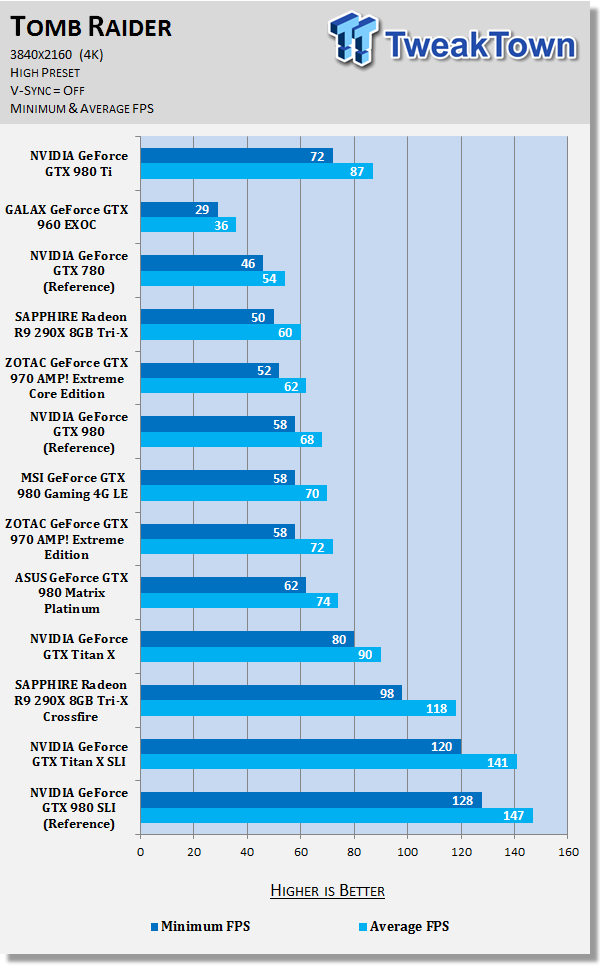
BioShock Infinite

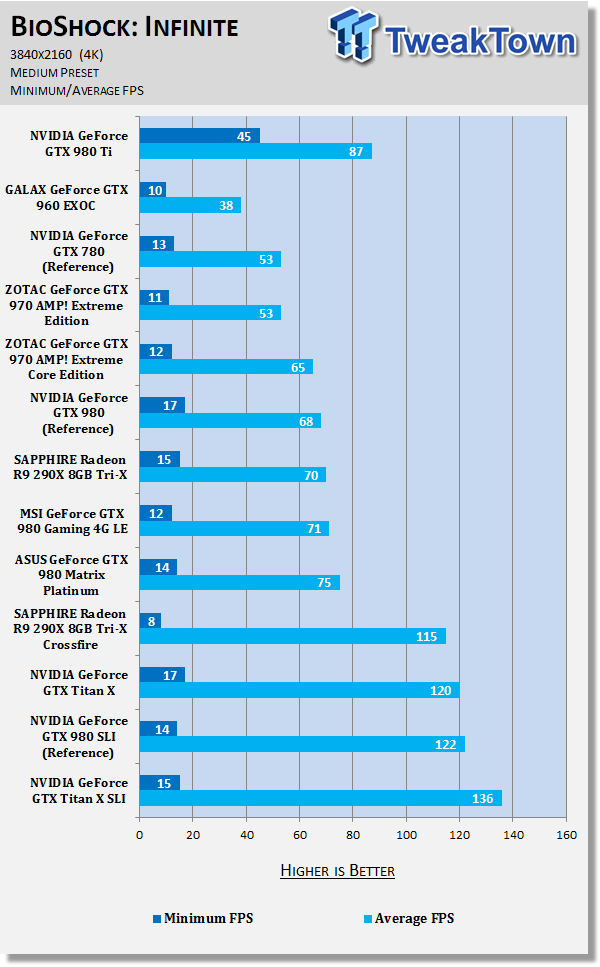
DiRT Showdown


You can find our performance summary of all of our gaming tests later in the review.
Performance Summary
How Does the NVIDIA GeForce GTX 980 Ti Perform?
NVIDIA is aiming the GeForce GTX 980 Ti at gamers that own the GeForce GTX 680 or GTX 780 Ti, and want a serious upgrade, something that the GTX 980 Ti will offer them. We haven't got any GTX 680 numbers, or GTX 780 Ti numbers unfortunately, but we do have GTX 780 numbers to compare them against.
So, what we're going to do with this review is see what the performance is like against three cards and then we're going to reevaluate the GTX 980 Ti in around another month when AMD drops its Fiji XT-based Radeon R9 390X.
We'll look at the GTX 980 Ti compared against the GTX 780, GTX 980 and the Titan X. It beats the GTX 780 and GTX 980 without a problem, and even keeps up with and sometimes beats the Titan X, which is astounding. The Titan X is a $999 card (in the US at least, it's over $1500 in Australia for example) and this is just the reference card. Just you wait until AIB partners get their hands on the GTX 980 Ti.
Performance at 1080p
As usual, we'll start with Battlefield 4 on our Ultra preset (minus AA) where the GTX 980 Ti starts off insanely well with 170FPS average. We are using some unreleased drivers which might give it a little advantage over our previous runs, but not by that much. The GTX 980 Ti beats the pants off of every other single GPU we've tested, including the Titan X.
The same goes for GRID Autosport, with the GTX 980 Ti performing beautifully with 163FPS average. Compare this to the 128FPS average of the GTX 780, 140FPS of the GTX 980 and 160FPS of the Titan X. Moving onto Metro: Last Light, the GTX 980 Ti domination continues with 100FPS average, equal to that of its GM200 brother, the Titan X. The GTX 780 is capable of just 62FPS here, while the GTX 980 scores 79FPS.
The newer games are where the Maxwell architecture, as well as the 384-bit memory bus on the GTX 980 Ti really come into play, like Middle-earth: Shadow of Mordor. We see the GTX 980 Ti scoring an insane 114FPS average, leaving the GTX 780 in its dust with just 58FPS. The GTX 980 does much better with 90FPS, but it still can't catch the GTX 980 Ti. The GTX 980 Ti can't beat the Titan X in SoM, but it doesn't lose by much... just 12FPS.
Moving onto Thief, the GTX 980 TI continues its domination with 104FPS average, nearly double that of the 61FPS that the GTX 780 manages. The GTX 980 is a little better here with 83FPS, while the Titan X pushes 108FPS.
Another game we were very surprised with is Tomb Raider, where the GTX 980 Ti spits out a huge 132FPS average. The GTX 780 manages only 76FPS, while the GTX 980 is capable of 144FPS. The Titan X is only a few frames better than the GTX 980 Ti, with the Titan X managing 138FPS.
Performance at 1440p
This is what I want to see: 139FPS average at 1440p on Battlefield 4 at Ultra details (minus AA)... which is what the GTX 980 Ti provides. Insanity, all of which is capable on a single video card. Comparing this to the 82FPS from the GTX 780 and 99FPS from the GTX 980, the GTX 980 Ti is a killer card for Battlefield 4 fans. The Titan X loses to the GTX 980 Ti here, with 118FPS on the Titan X versus 139FPS on the GTX 980 Ti.
The 384-bit memory bus really comes into play with the GTX 980 Ti in GRID Autosport, where it beats the Titan X with 152FPS versus the Titan X and its 146FPS. The GTX 780 only scores 94FPS here, while the GTX 980 pushes out much more with 126FPS.
Metro: Last Light has the GTX 980 Ti beating the Titan X once again, with 68FPS average versus the 66FPS on Titan X. The reference GTX 780 really loses out here with 43FPS, while the GTX 980 doesn't actually do too bad with 55FPS.
Moving on to Shadow of Mordor, the GTX 980 Ti manages to beat the pants off of the GTX 780 and GTX 980 with 83FPS compared to 50FPS and 65FPS for the GTX 780 and GTX 980, respectively. The Titan X is around 10% better here, with 91FPS - but not too far off the 83FPS from the GTX 980 Ti.
Thief surprises again with 72FPS, leaving the GTX 780 and its 40FPS in its dust. The GTX 980 manages 57FPS, while the Titan X is only a single frame better than the GTX 980 Ti with 73FPS versus 72FPS. Tomb Raider sees the GTX 980 Ti pushing 87FPS, leaving the GTX 780 and its 51FPS crying in the corner. The Maxwell-based GTX 980 is much more capable here with 69FPS average, but the Titan X wins here with 92FPS.
Performance at 4K
A brand new performance card is great at 1440p, but at 4K - this is where the fun will begin. Starting with Battlefield 4 at Ultra settings (minus AA), we have the GTX 980 Ti pushing out 78FPS average, compared to the 53FPS average of the GTX 780 and 59FPS of the GTX 980. The Titan X loses out to the GTX 980 Ti here, with 73FPS.
In GRID: Autosport, we have the GTX 980 Ti beating out the GTX 780 by a bigger margin, with 92FPS versus 54FPS. The GTX 980 is a little better with 71FPS, while the Titan X is out in front with 95FPS, just 3FPS better than the GTX 980 Ti.
Metro: Last Light has the GTX 980 Ti with a huge 71FPS, compared to just 38FPS on the GTX 780 and 51FPS on the GTX 980. It is just 2FPS from the Titan X, which manages 73FPS. Shadow of Mordor at 4K shows how great the new GTX 980 Ti is against the GTX 780, with 65FPS versus just 39FPS. The GTX 980 manages 52FPS, which is not too bad at all, but the Titan X wins with 70FPS.
Thief at 4K was good, with the GTX 980 Ti scoring 48FPS average, against the 25FPS average (unplayable in my standards) on the GTX 780, while the GTX 980 is slightly better with 37FPS. It manages to equal the Titan X here at 4K.
Lastly, the GTX 980 Ti scores 87FPS average in Tomb Raider, which is impressive against the 54FPS on the GTX 780, and 68FPS from the GTX 980. The Titan X wins here by just 3FPS, with 90FPS average.
Overclocking
Overclocking - Let's See How Far We Can Go
We've changed our charts for our video card overclocking results going forward, where we're just showing the GTX 980 Ti (or whatever video card we're reviewing next), followed by its overclocking results. Below, we have the GTX 980 Ti compared to its overclocked results, showing exactly what type of improvement you're going to see from the overclock we've managed.
[googleadr]We were able to push the Boost Clock from 1076MHz to a huge 1303MHz with 100% stability. At 1329MHz, we had a few issues, but it was perfect at 1303MHz. What kind of performance increase did we see? Some interesting results below.
Battlefield 4

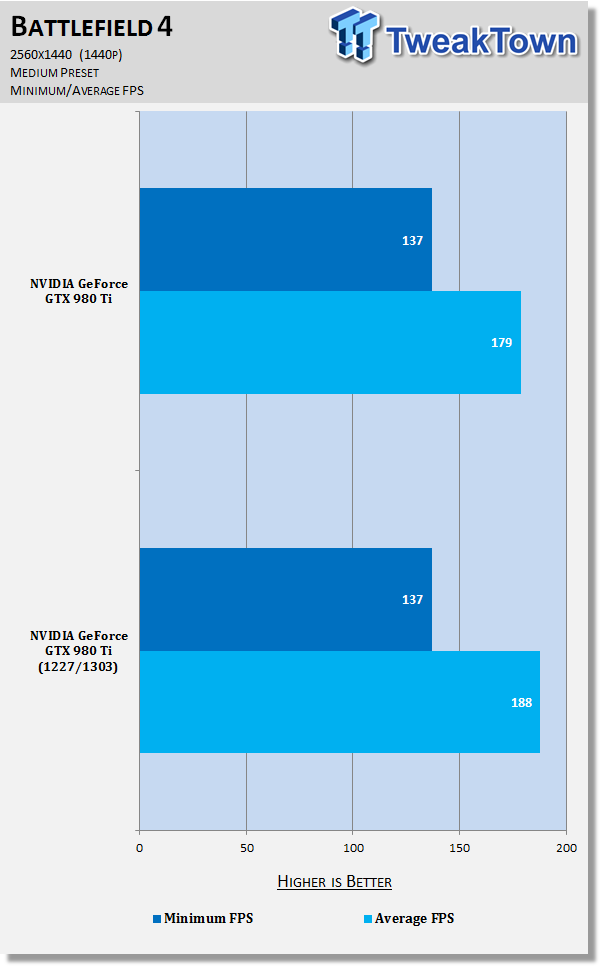
Metro: Last Light

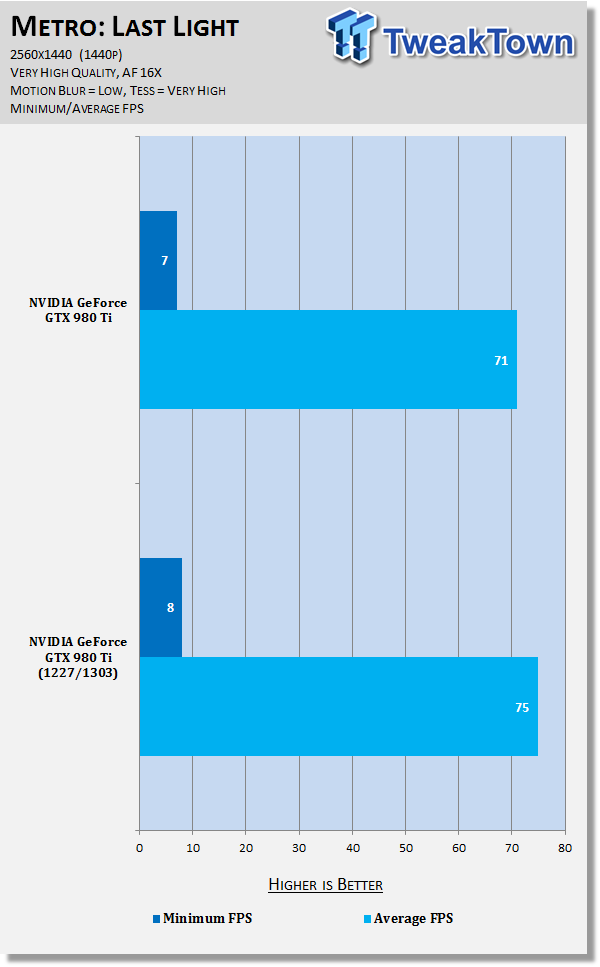
3DMark Fire Strike Extreme - 1440p
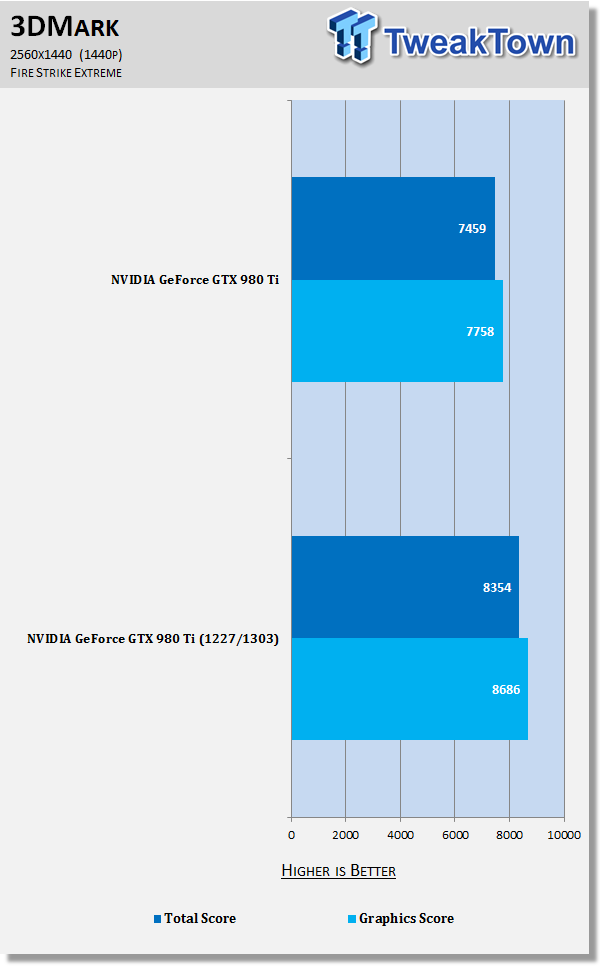
Heaven - 1440p

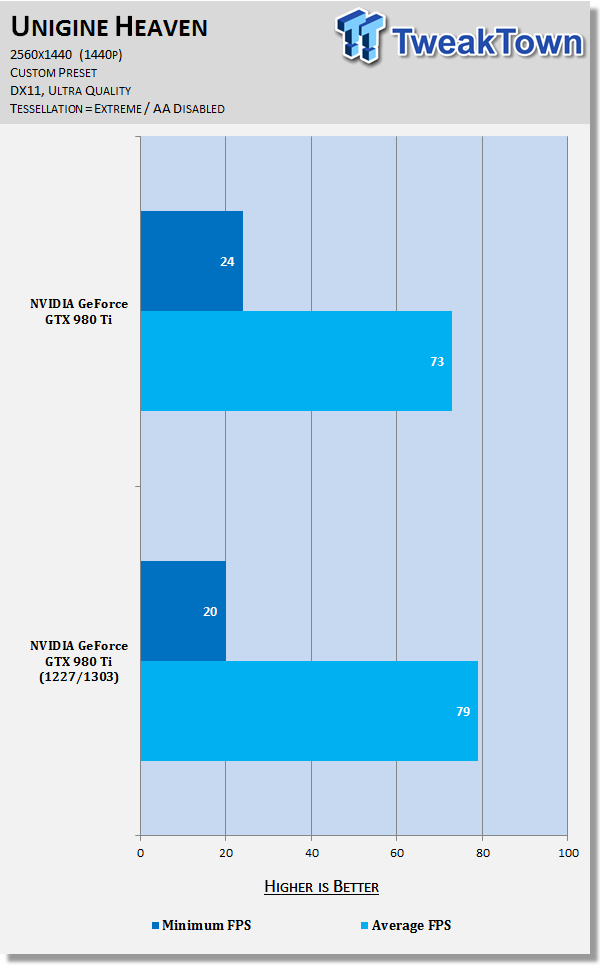
Power Consumption and Sound Testing
Power Consumption
With the GeForce GTX 980 Ti in our system, our entire PC was pulling around 360W of power in Battlefield 4 at 1440p. Comparing this to the 295W that the Titan X uses, and the 280W that the GTX 980 uses, the GTX 980 Ti chews a little more power.
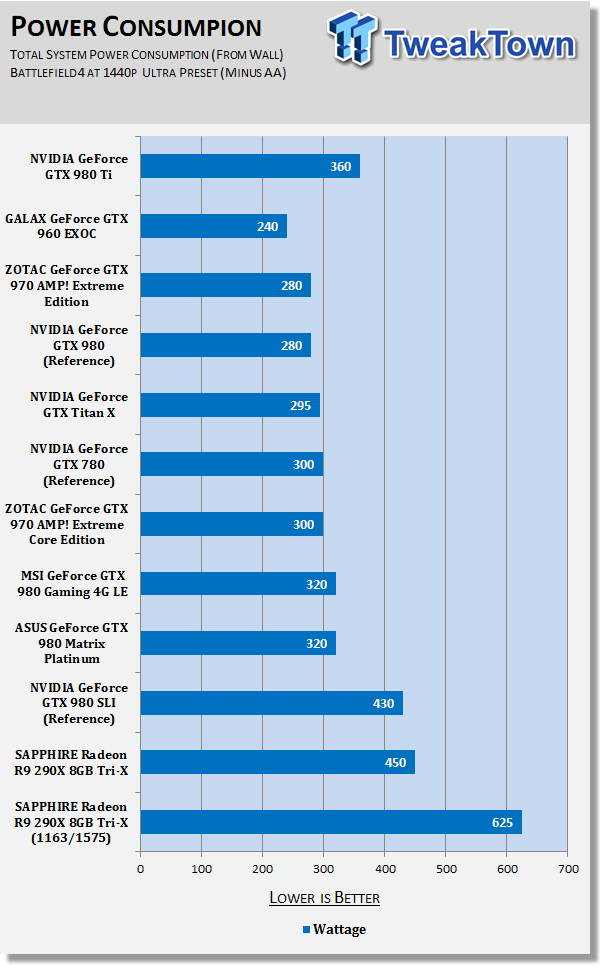
Sound Testing
Thanks to the GeForce GTX 980 Ti using the same blower style cooler that the GTX 980 and Titan X use, we have very similar performance when it comes to how loud it gets under stress. It's barely audible during gaming, and that's on an open air test bench. Inside of a case (which our testing will soon involve) is even better.
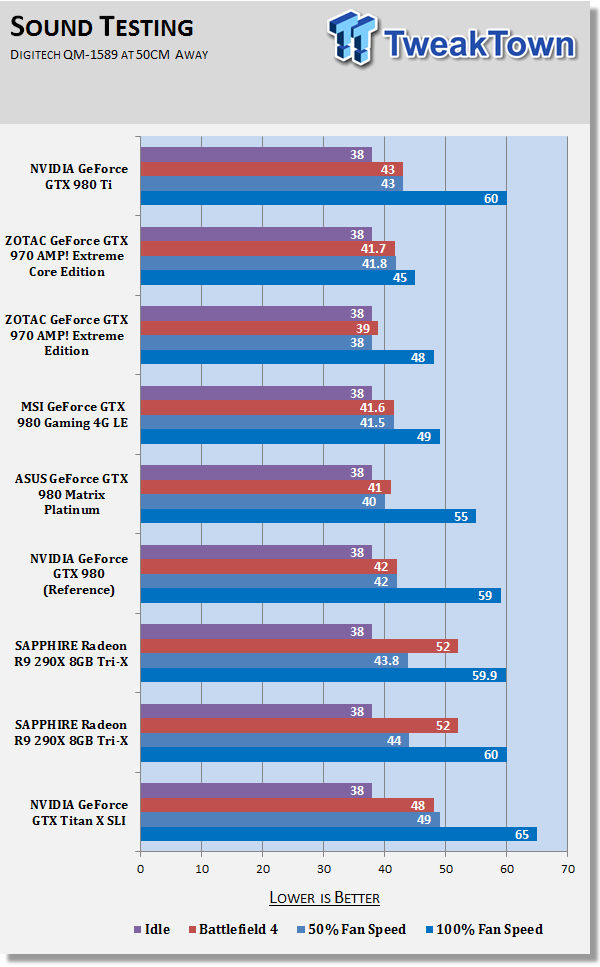
What's Hot, What's Not & Final Thoughts
This is where you can fast forward to the final section of the review, and get a quick recap and points on the NVIDIA GeForce GTX 980 Ti.
What's Hot
It Trades Blows With The GeForce GTX Titan X!!: NVIDIA has made a card that competes, and sometimes even beats, the best GPU it has made: the Titan X. The GeForce GTX 980 Ti is one of the fastest cards on the market right now.
Decent Price of $649: $649 isn't too expensive for a flagship video card, as we have the Titan X at $999... which means we should see aftermarket coolers adding around $50-$150 to that cost.
6GB of VRAM: With all signs pointing to the Radeon R9 390X having 4GB of VRAM, NVIDIA has provided some 'future proofing' in its GTX 980 Ti with 6GB of GDDR5 RAM.
Quiet Operation: What good is a new video card if it's making a heap of noise? The GTX 980 Ti barely makes a whisper, which is what you want. Just wait for those aftermarket cards and things will get even better!
Maxwell Architecture: NVIDIA's Maxwell architecture is what makes most of this possible, but we have the GM200 core here to thank, the same GPU that powers the Titan X.
What's Not
Nothing!: What can we complain about? We always want more performance and features. HBM. 16nm. Better cooler? NVIDIA has made the best video card yet with its GTX 980 Ti.
Final Thoughts
When I wrote my review on the GeForce GTX Titan X, I didn't think it could get much better. I presumed that NVIDIA would simply cut down the GM200 GPU and release a card that was gimped in order to keep the Titan X at the top of the heap... but boy was I wrong.
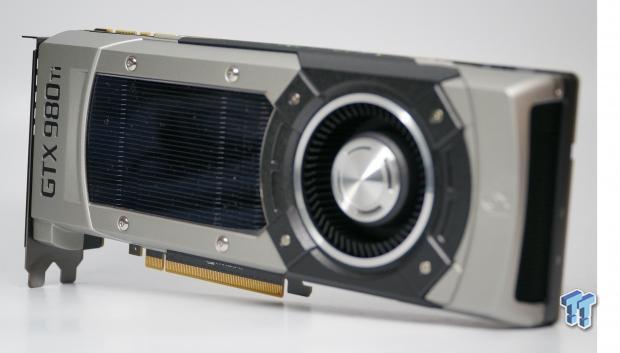
The GeForce GTX 980 Ti exceeds my expectations, as it is providing Titan X-like performance, at a much lower price. The Titan X is held back in a serious way from NVIDIA not allowing AIB partners to modify the cooling setup, so we haven't seen any exotic Titan X cards released. All that is about to change with the GTX 980 Ti, as we're going to see an avalanche of cards released in the coming months with all sorts of different cooling setups.
Right now, AMD is on the edge of releasing its Radeon R9 390X, but NVIDIA has swooped in and released the GeForce GTX 980 Ti to compete against it. The Radeon R9 390X now has a huge job of not just beating the Titan X, but it has to beat the GTX 980 Ti and importantly its price - as well as beat the GTX 980 Ti in terms of performance and thermals.
NVIDIA has pushed AMD right into a corner, and it's not just for performance. AMD is going to have to release the R9 390X and have it be faster than the GTX 980 Ti by say 10-20%, but price it competitively - either at the same price, or maybe $50-$100 more. If the R9 390X is say 10-20% faster, is it because of HBM? Shouldn't the R9 390X be faster because it's running a new architecture (Fiji XT) and next-generation High Bandwidth Memory? Remember, NVIDIA is still on the Maxwell architecture that debuted last year on the GTX 980, and they're still using GDDR5, not HBM.
It makes the GeForce GTX 980 Ti one of the best releases in a long time, something that gamers have been waiting for. Those who have been holding off on buying the GTX 980, and didn't like the high price of the Titan X, here's your chance to get in on the fun.

| Performance (overclocking, power) | 95% |
| Quality (build, design, cooling) | 95% |
| General Features (display outputs, etc) | 95% |
| Bundle, Packaging & Software | 95% |
| Value for Money | 90% |
| Overall | 94% |
The Bottom Line: NVIDIA ups the ante with the GeForce GTX 980 Ti, with Titan X level performance. This is the video card you've been waiting for, especially if you're upgrading from the GTX 680 or GTX 780 Ti. Where you at, AMD?
PRICING: You can find products similar to this one for sale below.
 United
States: Find other tech and computer products like this
over at Amazon.com
United
States: Find other tech and computer products like this
over at Amazon.com
 United
Kingdom: Find other tech and computer products like this
over at Amazon.co.uk
United
Kingdom: Find other tech and computer products like this
over at Amazon.co.uk
 Australia:
Find other tech and computer products like this over at Amazon.com.au
Australia:
Find other tech and computer products like this over at Amazon.com.au
 Canada:
Find other tech and computer products like this over at Amazon.ca
Canada:
Find other tech and computer products like this over at Amazon.ca
 Deutschland:
Finde andere Technik- und Computerprodukte wie dieses auf Amazon.de
Deutschland:
Finde andere Technik- und Computerprodukte wie dieses auf Amazon.de
What's in Anthony's PC?
- CPU: Intel Core i5-12600K
- MOTHERBOARD: GIGABYTE Z690 AERO-G
- RAM: Corsair 32GB DDR4-3200
- GPU: NVIDIA GeForce RTX 4090 24GB
- SSD: Sabrent 4TB Rocket 4 Plus
- OS: Windows 11 Pro
- CASE: Lian Li O11 Dynamic XL
- PSU: ASUS ROG Strix 850W
- KEYBOARD: Logitech G915 Wireless
- MOUSE: Logitech G502X Wireless
- MONITOR: LG C3 48-inch OLED TV 4K 120Hz
Similar Content
Related Tags

